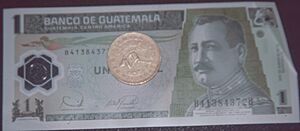Guatemalan quetzal facts for kids
Quick facts for kids Guatemalan quetzal |
|||
|---|---|---|---|
|
|||
| ISO 4217 Code | GTQ | ||
| User(s) | |||
| Inflation | 6.2% | ||
| Source | Link | ||
| Subunit | |||
| 1⁄100 | centavo | ||
| Symbol | Q | ||
| Plural | quetzales | ||
| Coins | 1, 5, 10, 25, 50 centavos, 1 quetzal | ||
| Banknotes | 1, 5, 10, 20, 50, 100, 200 quetzales | ||
| Printer | Polish Security Printing Works | ||
The quetzal (code: GTQ) is the official money used in Guatemala. It's named after Guatemala's national bird, the resplendent quetzal. Long ago, in the ancient Mayan culture, the beautiful tail feathers of the quetzal bird were actually used as a form of money!
One quetzal is made up of 100 smaller units called centavos. People in Guatemala sometimes use the slang word len (plural lenes) for centavos. When you talk about more than one quetzal, you say quetzales.
History of the Quetzal
The quetzal was first introduced in 1925. This happened when José María Orellana was the President of Guatemala. You can even see his picture on the front of the one-quetzal banknote! The quetzal replaced the old money, which was called the Guatemalan peso. One quetzal was worth 60 pesos.
For many years, until 1987, the quetzal was linked to the United States dollar. This meant that one quetzal was worth the same as one U.S. dollar in Guatemala.
Coins of Guatemala
When the quetzal was first introduced in 1925, coins were made in different values. These included 1, 5, and 10 centavos, and also 1⁄4, 1⁄2, and 1 quetzal coins. However, most of the 1 quetzal coins were later taken out of use. In 1932, 1⁄2 and 2 centavo coins were added.
Until 1965, coins worth 5 centavos and more were made from silver. Later, in 1998 and 1999, the 1⁄2 and 1 quetzal coins were brought back into use.
Today, the coins you'll find in Guatemala are round. On one side, they feature Guatemala's national coat of arms. Here's what you'll find on the other side of each coin:
- 1 centavo: Shows Friar Bartolomé de las Casas, an important historical figure.
- 5 centavos: Features the tree of liberty and the phrase "LIBRE CREZCA FECUNDO" which means "Grow free and fruitful".
- 10 centavos: Has a large stone monument from Quiriguá, an ancient Mayan city.
- 25 centavos: Shows an indigenous woman named Concepción Ramírez.
- 50 centavos: Features the Monja Blanca, which is Guatemala's national flower.
- 1 quetzal: Displays a stylized dove, the word "Paz" (meaning "Peace"), and the date "29 de Diciembre de 1996" (December 29, 1996). This date marks an important peace agreement.
Banknotes of Guatemala
The first paper money, or banknotes, were printed by the Central Bank of Guatemala. They came in values of 1, 2, 5, 10, 20, and 100 quetzales. In 1933, 1⁄2 quetzal notes were also added.
In 1946, the Bank of Guatemala took over printing the money. The first notes they issued were actually older notes with new stamps on them. The values of the banknotes stayed mostly the same until the late 1990s. That's when the 1⁄2 and 1 quetzal paper notes were replaced by coins.
On the top-right corner of the front of each banknote, you'll see the value written in Mayan numbers. This is a special way to show Guatemala's rich cultural history.
| Image | Value | Main Color | Description | Remark | ||
|---|---|---|---|---|---|---|
| Obverse | Reverse | |||||
| Q0.50 | Brown | Tecún Umán, a brave prince and leader during the Spanish Conquest. | Tikal's Temple I, an ancient Mayan pyramid. | No longer in circulation | ||
| Q1 | Green | José María Orellana, the President who introduced the quetzal as Guatemala's money. | The main building of the Central Bank of Guatemala. | Reintroduced as a polymer banknote on August 20, 2007 | ||
| Q5 | Violet | Justo Rufino Barrios, a key leader of the Liberal Revolution of 1871. | A picture representing education. | Changed to a polymer banknote on November 14, 2011 | ||
| Q10 | Red | Miguel García Granados, another important leader of the Liberal Revolution of 1871. | A picture from the Guatemalan National Assembly of 1872. | |||
| Q20 | Blue | Mariano Gálvez, a state leader of Guatemala during its early history. | Shows the signing of the declaration of Central American independence. | |||
| Q50 | Orange | Carlos Zachrisson, who was a finance minister. | A picture showing how important coffee is to Guatemala. | |||
| Q100 | Sepia | Francisco Marroquín, the first Bishop of Guatemala and founder of the Universidad de San Carlos de Guatemala. | The first university building in Antigua Guatemala. | |||
| Q200 | Aqua | Sebastian Hurtado, Mariano Valverde, and German Alcántara. These are three famous marimba composers. | A picture of the marimba, which is Guatemala's national instrument, and music notes from "La Flor del Café" by Alcántara. | |||
| For table standards, see the banknote specification table. | ||||||
The Bank of Guatemala has also started using special plastic-like banknotes, called polymer banknotes. A 1 quetzal polymer banknote was introduced on August 20, 2007. A 5 quetzal polymer banknote followed on November 14, 2011.
See also
 In Spanish: Quetzal (moneda) para niños
In Spanish: Quetzal (moneda) para niños
- Economy of Guatemala



